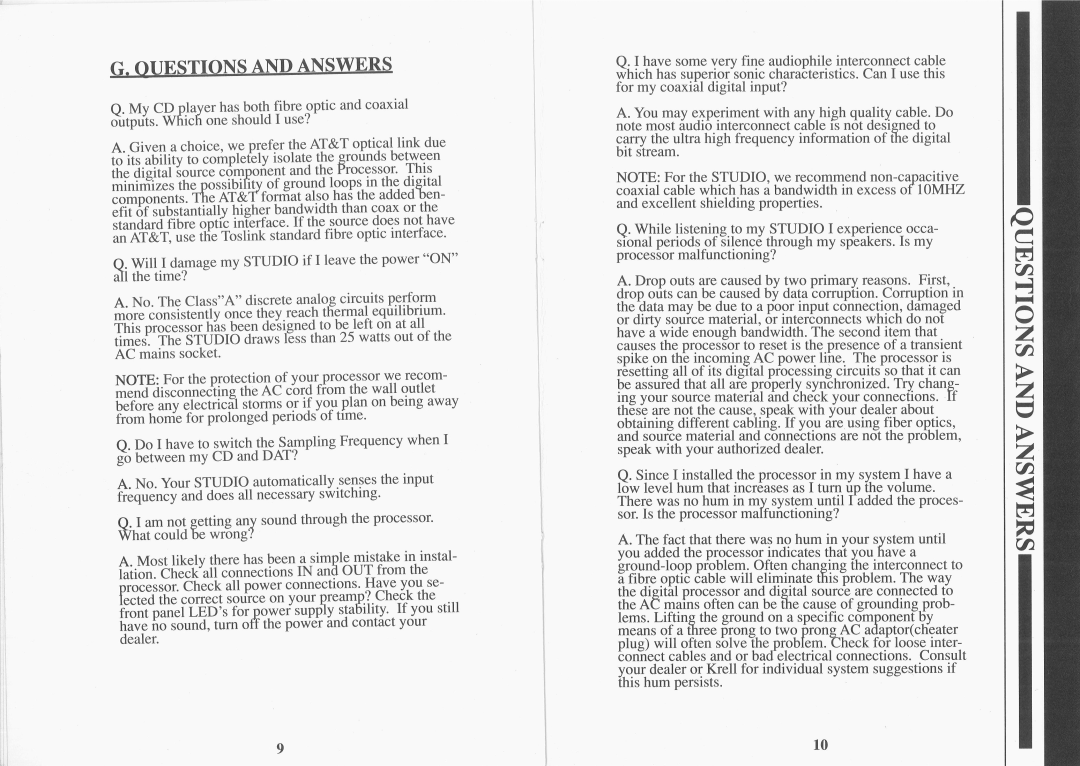
G. QUESTIONS AND ANSWERS
Q. MyCDpla~,er has both fibre optic and coaxial outputs. Whichone should I use?
A. Givena choice, weprefer the AT&Toptical link due to its ability to completelyisolate the groundsbetween the digital source componentand the Processor. This minimizesthe possibifity of groundloops in the digital components.The AT&Tformat also has the
an AT&T,use the Toslink standard fibre optic interface.
a~ Will I damagemy STUDIOif I leave the power "ON" i the time?
"" iscrete analo.g circuits, P.,.erform, . A. No. TheClass A d
moreconsistently once they reach thermal equlnorlum. This processorhas beendesignedto be left on at all times. The STUDIOdraws less than 25 watts out of the ACmains socket.
NOTE:For the protection of your processor we recom- menddisconnecting the ACcord f?omthe wall outlet
before any electrical storms or if youplan on being away from homefor prolonged periods of time.
Q. DoI have to switch the SamplingFrequencywhenI go between my CDand DAT?
A. No. Your STUDIOautomatically senses the input frequencyand does all necessary switching.
~I amnot getting an), soundthroughthe processor. hat could oe wrong:
A.Mostlikely there has been a simplemistakein instal- lation. Checkall connections IN and OUTfrom the
FerOCessorCheckall powerconnections. Haveyou se- cted the" correc,t sourceon your preamp?Che_b~kthe front panel LEDs forpowersupplystability. It youstill
have no sound, turn off the powerand contact your dealer.
Q. I have somevery fine audiophile interconnect cable whichhas superior sonic characteristics. CanI use this for mycoaxial digital input?
A. Youmaye.x. perimentwith any high quality cable. Do note mostauclio interconnect cable is not designedto carry the ultra high frequencyinformationof the digital bit stream.
NOTE:For the STUDIO,we
Q. While listening to mySTUDIO experience occa- sional periods of silence through myspeakers. Is my processor malfunctioning?
A. Dropouts are caused by two primary reasons. First, drop outs can be caused by data corruption. Corruptionin the data maybe due to a poor input connection, damaged
or dirty source material, or interconnects whichdo. not have a wide enoughbandwidth. The second item that causes the processorto reset is the presenceof a transient
spike on the incomingACpowerline. The processor is resetting all of its digital processingcircuits so that it can
be assured that all are properly synchronized.Try chang- ing your source material and check your connections..If these are not the cause, speak with your dealer about obtainingdifferent cabling. If youare using fiber optics, and source material and connections are not the problem, speak with your authorized dealer.
Q. Since I installed the processor in mysystemI havea lowlevel humthat increases as I turn up the volume. There was no humin mysystem until I added the proces- sor. Is the processor malfunctioning?
A. Thefact that there wasno humi.n your systemuntil youaddedthe processor indicates that you have a
9 | 10 |
